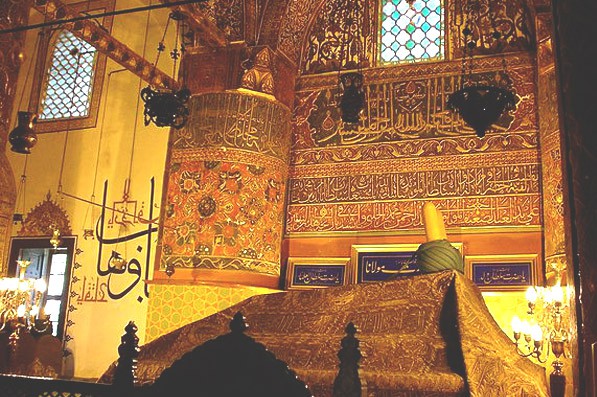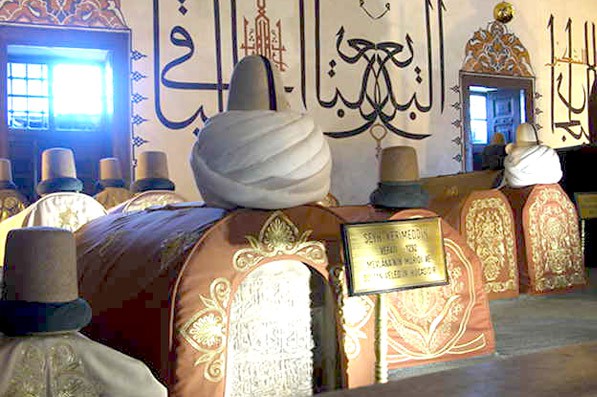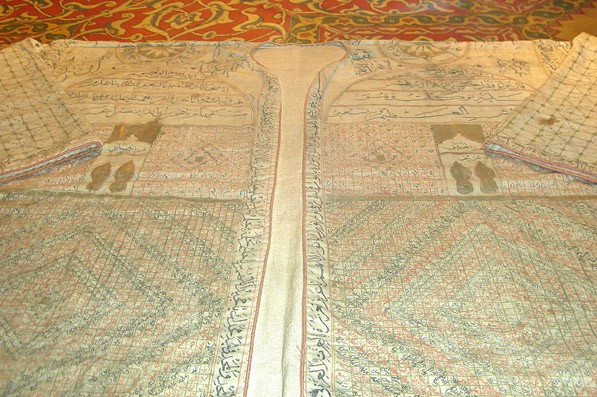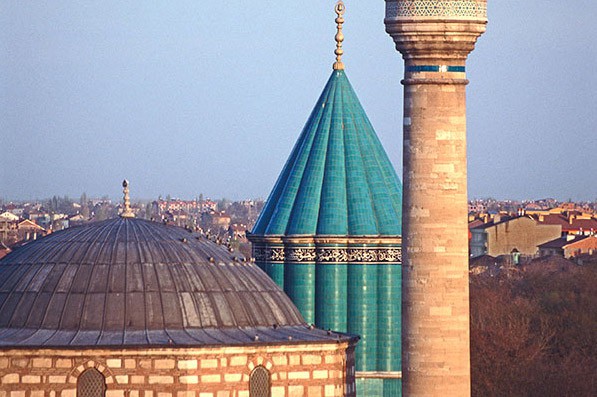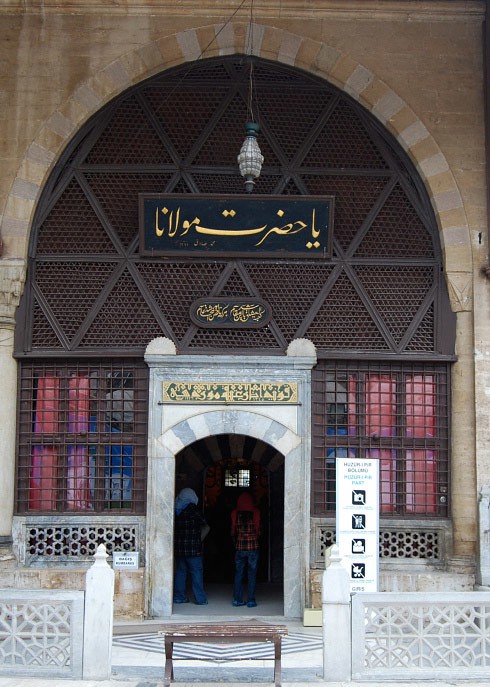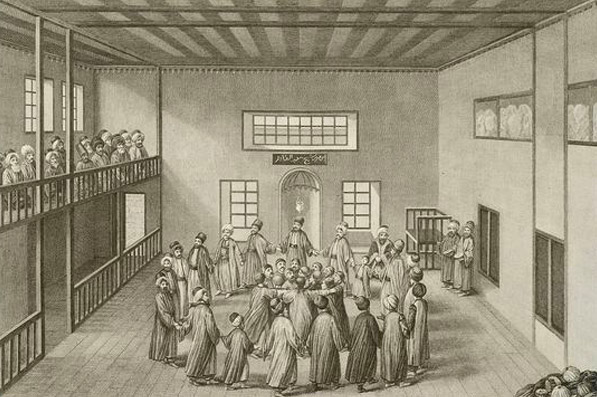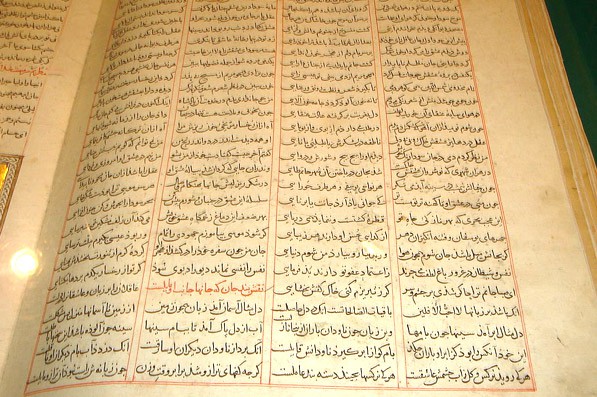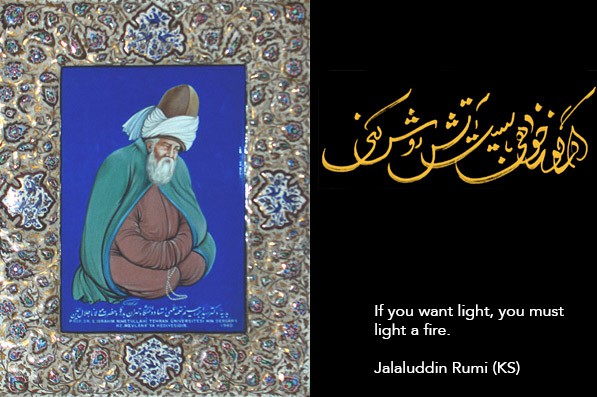Jalaluddin Rumi (KS) – URS 5 Jumada al-Thani (29 Dec 2022)
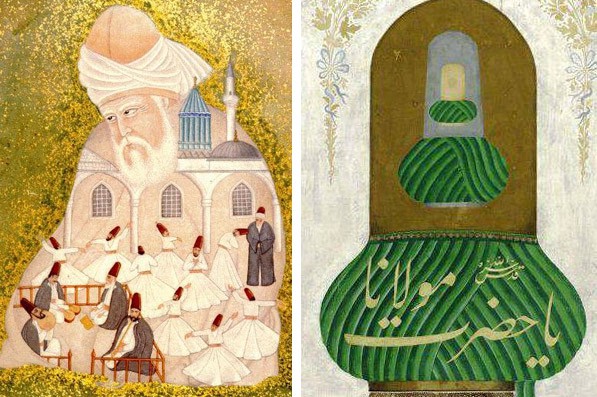
Jalaluddin Rumi (KS) b. Bahā’ al-Dīn Walad b. Ḥusayn b. Aḥmad Khaṭibi was i. His birth name was the same as his father’s: Muḥammad (SWS). From an early age, his father called him Jalāl al-Dīn (“The glory of the Religion”). He was also called by the Arabic title, Mawlana (“our Master”), as was his father. In addition, his disciples called him by the Persian title, Khodāwandgar (“great Master”). He was known as Rumi (“Roman”) because he spent most of his life in the region known by Muslims as “Rum,” the Anatolian peninsula most of which had been conquered by the Saljuq Turks after centuries of rule by the Eastern (Byzantine) Roman Empire.
Jalaluddin Rumi (KS) is also one of the great grandfathers of Maulana Sheikh Nazim al-Haqqani ar-Rabbani (KS), Sultan al-Awliya of Naqshandi Golden chain order.
Jalaluddin Rumi (KS)
Mawlana has long been viewed as one of the greatest Persian poets and has been called “surely the greatest mystical poet in the history of mankind” (Arberry, 1949, p. xix). He is the author of the following poetic works: Divan-e Kabir (“Great Collected Poetic Works”) or Divan-e Shams-i Tabrizi (which contains, in the earliest manuscripts, more than 3,000 ghazaliyāt or lyric poems, 40 tariqat or stanzaic poems, and over 1800 rubāc īyāt or quatrains) and Mathnawi-ye Manawi (“Couplets of Deep Spiritual Meaning”), considered his greatest work that was composed in his later years, which contains over 25,000 authentic verses).
Over the centuries, many verses and poems, as well as “improvements” within verses, have been added to the manuscript tradition; and more inauthentic verses and poems are claimed as belonging to Mawlana in contemporary books and articles. His prose works, believed to have been compiled after his death, are Fihi Ma Fihi (“It is, What It IS,” also known as the “Discourses of Rumi”), Majalis-e Saba (“Seven Sessions,” also known as the “Sermons”), and Maktubat (“Letters”).
Background
The basic story of Mawlan’s life is well known: how he emigrated from Balkh with his family just prior to its destruction by the Mongol army of Genghis Khan, travelled from place to place (including Mecca) with his family before living in several towns in Anatolia (in present day Turkey) and moving finally to Konya (the ancient city of Iconium), succeeded his father who was a renowned religious scholar, met the wandering dervish Shams al-Dīn of Tabrīz who had a transforming impact on his life, became troubled by the jealousy of his followers that led to the first disappearance of Shams, sent his oldest son (Sulṭan Walad) to bring Shams back from Damascus, became completely distraught when Shams disappeared permanently, then became more profoundly creative, by Divine Inspiration, than ever before as a mystical poet, and was succeeded (following the death of his chief disciple, Ḥusām al-Dīn Chalabi) by Sulṭān Walad, who was the first to organize the tradition of the Mawlawi (Mevlevi) Sufis—later known in the West as the “Whirling Dervishes.”
Birth
According to Sepahsalar, who wrote that he was Mawlana’s direct disciple, Jalaluddin Rumi’s (KS) birth was in the year 1207 C.E. And Aflaki also accepted this year in his hagiography, written at the request of Mawlana’s grandson (between 1318-1353) and mentioned the full date as September 30, 1207 (6 Rabi al-Awwal 604 A.H.). However, some Mawlana scholars have thought there was evidence of an earlier birth year, but this view has not been accepted by most scholars (Lewis, pp. 317-20).
There is evidence, based on his father’s journal, Ma’Arif, that Mawlana was born in Wakhsh (now in Takijistan), about 240 kilometers northeast of Balkh in the valley of the Wakhsh River (which flows into the Amu Darya, or Oxus River), where his father lived and worked as a jurist and preacher between 1204 and 1210 (Bausani, 1965, p. 393; Meier; Schimmel, p. 11; Lewis, pp. 47-49). The town of Wakhsh was culturally a part of the city of Balkh. In the year 1212, Mawlana’s father moved with his family to Samarqand (now in Uzbekistān). Mawlana and his family emigrated from there to Anatolia about 1216 or 1217. Since there is reason to believe that Mawlana lived in Balkh for some period of time, this gives justification to view him as from Balkh, a “Balkhi.”
Early Sufi Training
Many books and articles about Mawlana’s life depict him as a conventional religious intellectual, an Islamic scholar and judge (as his father tends to be described), who suddenly was transformed into a mystic after meeting Shams-e Tabrizi. While there is no doubt that his experiences with Shams-e Tabrizi were greatly transformative, Mawlana had previously undergone nine years of Sufi training under his father’s leading disciple and successor, Sayyid Burhān al-Dīn Muḥaqqiq al-Tirmidhi (KS), known as the “Knower of Secrets” (Sirr-Dān).
Sayyid Burhān al-Dīn (KS) arrived in Konya in 1232, a year after Mawlana’s father died. During part of these years of Sufi discipleship, the Sayyid directed Mawlana to go to Syria and master the traditional Islamic domains of knowledge. He first went to Aleppo, where he studied at the Madrasa-i Halawiyya (a college of the Ḥanafī school of Sunnī Islamic law) and where he associated with some disciples of his father. After completing his studies, he returned to Anatolia and the Sayyid directed him to do several Forty-Day Seclusions (spiritual retreats).
The Sayyid was said to be so impressed by Mawlana’s spiritual state, after completing these retreats, that he declared him to be without equal in the world in the major branches of knowledge as well as of hidden spiritual secrets (Aflaki, pp. 83-84). In the year 1241, Mawlana received word that Sayyid Burhan al-Din had died and went to visit his teacher’s tomb (in Qaysarīya). Sayyid Burhān al-Din (KS) was a mature mystic who loved to quote from the Sufi poetry of Sana’i.
Marriage
Mawlana was married all his life from about the age of eighteen, and he was very devoted to his two wives. His first marriage was to Gawhar (“Pearl”), whom he had known since childhood. She was the daughter of one of his father’s disciples (Sharaf al-Dīn Lala of Samarqand), who had accompanied the family during their migrations. The marriage took place in the town of Laranda (present day Karaman), which was not far from Konya. It was there, during period of seven years, that Mawlana’s sons, Baha’ al-Din Muḥammad Walad (known as Sulṭān Walad) and c Ala’ al-Dīn Muḥammad were born; it was also where his mother, his wife’s mother, and his brother Ala’ al-Dan died. The family then moved to Konya in 1228. His wife died there at a young age, and later on he married a widow (who had a son), Kerra of Konya, with whom he had a third son, Muẓaffar al-Dīn Amir Alim, and a daughter, Malika.
Mawlana’s second Sufi master, Shams-i Tabrizi (KS), arrived in Konya on November 29, 1244 (Aflaki, p. 84). Aflaki called him “Mawlana Shamsu‘l-Ḥaqq wa ‘l-Dīn Muḥammad, ibn Ali, ibn Malakdad al-Tabrizi” (p. 614). According to early Mawlawi (Mevlevi) tradition, the spiritual tradition of Mawlana’s successors, he was said to be 60 years of age (Forūzānfar, p. 50). Later on, Shams asked to marry a young woman raised in Mawlana’s household named Kimiya, and after they married they lived in Mawlana’s household (Sepahsalar, p. 133).
Although Shams-i Tabrizi (KS) has been described for more than a century as a wandering charasmatic dervish, we now know, based on the notes of his discourses (thanks to scholars such as Franklin Lewis and William Chittick) (Maqalat-i Shams-i Tabrizi) that were recorded by his disciples (one of whom was Mawlana’s son, Sultan Walad), that he had a solid Islamic education in the Arabic language, he was a Sunni Muslim who followed the Shafi school of Islamic law.
He must have memorized the Qur’an, since he taught young boys its memorization (Chittick, p. xvi). Shams al-Dīn placed much importance on “following” [mutāba at], meaning following the Sunnah or the example of the behavior that was modeled by the Prophet Muḥammad (SWS). Shams-i Tabrizi (KS) was critical toward a number of well-known Sufi masters (contemporary and past ones) because they did not follow the example of the Holy Prophet (SWS) sufficiently, and some apparently felt they were so spiritually advanced that they had little need for it (Lewis, p. 150, 156-58).
Based on this understanding, the initial meeting between Shams and Mawlana can be seen in a new light: Shams was searching for one of the great hidden saints of God, and one of the proofs of such a person would be a humble veneration and love of the Prophet Muḥammad (SWS), combined with a strong commitment to following the Prophet’s (SWS) pious way of life. This would be in contrast to other Sufis who made claims of receiving extraordinary spiritual favors from God but who had a lack of commitment to following the Prophet’s (SWS) example.
Shams-i Tabrizi (KS) Request for Someone Who Could Endure Him
Shams had travelled throughout the Middle East searching and praying for someone who could “endure my company”. A voice said to him, “What will you give in return?” Shams replied, “My head!” The voice then said, “The one you seek is Jalaluddin of Konya.”
On the night of 5 December 1248, as Rumi (KS) and Shams (KS) were talking, Shams was called to the back door. He went out, never to be seen again.
First Account Meeting between Shamsi Tabrizi (KS) & Jalaluddin Rumi (KS)
The first account is generally preferred by popularizing Western authors because it fits their view that Mawlana had been a mere Muslim scholar and theologian until he met Shams, who introduced him to radical mystical teachings. According to the first version (pp. 84-87), Shams challenged Mawlana with quotes from the Prophet Muḥammad (SWS) and the (9th century C.E.) Sufi, Bayazid al-Bistami (KS) (also spelled Abu Yazid):
“Say who was greater: Ḥazrat-i Muḥammad (SWS) the Prophet or Bayazid?” He answered, “No, no! Muḥammad Muṣṭafa (SWS), the leader and chief of all the prophets and saints! And greatness belongs to him!” Shams then said, “Then what does it mean that Ḥazrat-i Muṣṭafa (SWS) said (to God), ‘Glory be to You! We have not known You as You deserve to be known’ and Bayazid said, ‘Glory be to me! How great is my state! And I am the King of kings!’’
Mawlana is then depicted as falling from his mule from awe of that reply, shouting, fainting, and sleeping for an hour. After returning to his senses, he is described as taking Shams by foot to his (religious) college, into a small cell in which no one was given passage until forty days were completed, or three months according to others.
Aflaki’s second version portrays Mawlana as a faithful Muslim who revered the Prophet Muḥammad (SWS) more than anyone, and Shams-i Tabrizi (KS) is depicted as the one who fainted after hearing Mawlana’s reply:
For Abu Yazid (KS), (his) thirst became pacified by a gulp (of water), he spoke from (feeling) satiated, and the jug of his comprehension was filled by that amount. And that light was (suited to) the measure of the window of his house. But for Ḥazrat-i Musṭafa (SWS)—(may peace of God be upon him), there was tremendous thirst, (there was) thirst after thirst.… Necessarily, he spoke about thirstiness and every day he became increased in his supplications for (greater) nearness (to God). And (so) of these two assertions, the assertion of Mustafa (SWS) is greater. Because (Abu Yazid) arrived (near) to God, viewed himself as full, and did not look (for) more. But Mustafa (SWS)—peace be upon him—saw more every day and went further. (And) day by day, hour after hour, he witnessed more of the Lights, Grandeur, Power, and Wisdom of God. For this reason he said, “We have not known You as You deserve to be known.”
Both are then described as falling into a state of spiritual ecstasy, after which Mawlana took Shams into a small cell that belonged to a close disciple (Shaykh Ṣalāḥ al-Dīn Zarkob) for a period of six months.
Jalaluddin Rumi (KS) Mureeds feel Neglected and Jealousy Increases
Mawlana wanted to spend most of his time with his newly found spiritual master. During the initial period of Shams’ stay in Konya (of about 16 months), Mawlana’s disciples had felt neglected and when their jealousy steadily increased, Shams-i Tabrizi (KS) left Konya and went to Syria. Two dates were given by Aflaki for this departure: March 21, 1245 (p. 88) and March 11, 1246 (pp. 629-30); the later date is considered more reliable since it was written in Arabic (Lewis, p. 177; Muwaḥḥid, 2000, p. 207). It appears that he returned and left again for Syria a second time, seven days after his wife Kimiya died, about December 1246 (Aflaki, p. 642, Muwaḥḥid, p. 207).
He returned only after Mawlana sent his son, Sultan Walad, with a group to invite him back. According to Aflaki, Shams was murdered by some of Mawlana’s jealous disciples on a Thursday sometime during the Islamic lunar year that occurred between May 1247 and April 1248 (p. 686). This is just conjecture and no proof has been found.
The total time that Mawlana spent with his greatest spiritual master appears to have been less than three years: from the end of November 1244 to April 1248, minus a seven month stay in Aleppo (mentioned by Shams himself, p. 359, a stay that apparently preceded going to Damascus) and minus his time in Damascus and the travel time between Damascus and Konya for two or three journeys. Historical from various Islamic Saints accounts say they were together for much longer time.
First of all, it seems unlikely that Mawlana’s family and disciples could have kept such a murder secret from him. Neither his son Sulṭān Walad nor Sepahsālār mention a murder in their works that are earlier than Aflaki’s work (Lewis, p. 185). No witnesses saw Shams die, because he supposedly disappeared miraculously after being wounded (Aflākī, p. 684). Although there is a shrine in Konya dedicated to Shams-é Tabrīzī, the claim that his body was thrown down a plugged-up well in Konya and buried next to the body of the founder of Mawlānā’s religious college, Amīr Bahā al-Dīn Gawhartāsh (Aflākī, pp. 700-01), has been refuted because only one grave was found, presumably that of Gawhartāsh (Lewis, pp. 188-90). Even if Mawlānā was told that Shams was murdered in Konya, he clearly did not believe it, because he made two trips to Syria to look for Shams (Sepahsālār, p. 134).
And finally, there is evidence that Shams-i Tabrizi (KS) may have been buried, not in Konya, or in Tabriz (where there is also an alleged tomb of Shams), but in the town of Khôy (now in Iran, about 50 kilometers east of the present Turkish border, on the road to Tabriz), where a Sultan of the Ottoman Empire went to pay his respects to the tomb of Shams in the early 16th century C.E. (Mowaḥḥid, p. 209). More pertinent are Shams’ reported statements about leaving permanently, such as his threat to disappear in such a way that,
“I will become so absent that no trace of me as a created being will be found” (Sepahsālār, p. 134; see Sulṭān Walad, pp. 50-51). And he hinted that he would need to leave permanently in order to further Mawlānā’s development as a spiritual master. For example, in one speech recorded by his disciples (pp. 163-64) in which he appears to have addressed Mawlānā he said:
“ Since I am not in the situation where I might order travel for you, I will place (the need for) travel upon myself for the welfare of your work, because separation is a cook… What is the value of that work (of yours)? I would make fifty journeys for your welfare. My travels are for the sake of the (successful) emergence of your work. Otherwise, what’s the distinction for me between Anatolia and Syria? There’s no difference (if) I am at the Kaaba (in Mecca) or in Istanbul. But it’s certainly the case that separation cooks and refines (the seeker). ”
After Mawlana made two journeys to Damascus and failed to find Shams, his son, Sulṭān Walad wrote (p. 50, 52):
He did not find Shams-i Tabrizi in Syria; (instead) he found him within himself, like the clear moon. He said, “Although we are far from him in body, without (consideration of) body and spirit we both are one light. Whether you see him or me, I am him (and) he is me, (O) seeker…” He said, “Since I am him, (for) what do I search? Now (that) I am his very substance, I may speak from my (very) self.”
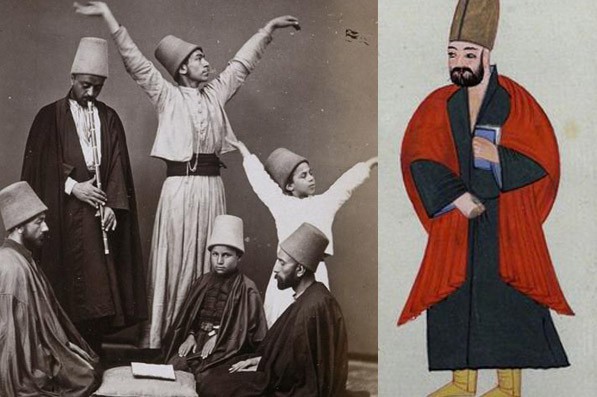
After Shamsi Tabrizi (KS) Disappearance
After a period of several years of suffering greatly because of the disappearance of Shams, Mawlana declared (in 1249) that Shams had appeared to him in the form of one of his close disciples, named Shaykh Ṣalāḥ al-Dīn Zarkôb.
He put Ṣalāḥ al-Dīn in charge of training his disciples, which made them almost as jealous as they had been toward Shams. But Mawlānā found out about this out and threatened to abandon his disciples completely unless they ceased complaining.
In popular works about Mawlana, Ṣalāḥ al-Dīn tends to be portrayed as little more than a illiterate tradesman. Although he evidently could not read or write, he was actually the most senior dervish. He had been a Sufi disciple of Sayyid Burhān al-Dīn together with Mawlana. In addition, Ṣalāḥ al-Dīn had also been a disciple of Shams-i Tabrizi (KS) (Sepahsālār, p. 134).
Furthermore, Mawlana recommended that his son accept Ṣalāḥ al-Dīn as his Sufi shaykh (Sulṭān Walad, p. 275) and he arranged for his son to marry Ṣalāḥ al-Dīn’s daughter, Faṭima, whom Mawlana had taught to write and read the Qur’ān (Aflākī, p. 719).
Ṣalaḥ al-Din maintained his post of teaching and training the disciples to become dervishes for a period of ten years and died in 1258. Mawlana then saw the reflection of Shams in another disciple, Ḥusam al-Din Chalabī, whom he promoted to be the teacher of the disciples. It was Ḥusam al-Din who inspired Mawlana to compose rhymed couplets [Mathnawi] in the manner of Farīd al-Dīn al-Dīn Aṭṭār, and Mawlānā then began to compose his Mathnawi through Divine Inspiration.
After the death of Mawlānā in 1273, Ḥusām al-Din became his first successor until his death in 1283. Mawlana’s son, Sulṭān Walad, then humbly accepted the most senior and advanced dervish of his father’s disciples, Karim al-Dīn Walad-i Baktamur, to be the chief trainer of the disciples for a period of seven years (Sulṭān Walad, p. 275).
After Karim al-Din died (about 1291 or 1292), Sulṭan Walad became the clear leader of the disciples and founded the first branches of the “Mawlawi” form of Sufism beyond Konya. Other Sufi orders of the time commonly engaged in mystical practices involving music and ecstatic dance-like movements, but these practices became of central importance to the Mawlawī order.
The ecstatic whirling so frequently done by Mawlana during “mystical concerts” [Samā ] was first formalized into the famous Mawlawi whirling prayer ritual by Pir Adil Chelebi, who died in 1460 (Bausani, p. 394; Lewis, p. 444).
According to Aflākī, Mawlānā did not engage in the “mystical concert” in his youth, but was later encouraged to do so by his wife Kerrā’s mother. When he began to participate, he would mainly wave his hands, a common practices of Sufis in such sessions.
Later, Shams-i Tabrizi (KS) showed him how to whirl [charkh zadan] (Aflākī, p. 681). According to Sepahsālār, on the other hand, Mawlana did not participate in such gatherings until after he met Shams-i Tabrizi (KS), who indicated to him, “Enter into the mystical concert, for that which you are seeking will become increased in the mystical concert”.
It should be stressed that Muslim Sufis had already been engaging in the ecstatic movements of the mystical concert for four centuries before Mawlana’s time, since the middle of the 9th century C.E., starting in Baghdad, a practice that spread very quickly, especially among Persian Sufis (During, p. 1018). There are indications that Mawlana composed poetry specifically to be recited, chanted, or sung during mystical concerts—and that he composed poetry while engaged in such sessions, especially when whirling (Lewis, p. 172, pp. 314-15).
Very rarely does one read in English the words, “Rumi was a Muslim.” In most of the popularized translations and versions of Mawlana’s poetry, his strong adherence to Islamic piety is minimized or ignored: verses are changed or skipped in order to avoid references to the Qur’an or the Traditions (Aḥadith) of the Holy Prophet Muḥammad (SWS), and even references to prayer and the mention of God are often avoided. Such minimizations of Mawlana’s commitment to Islam have also helped interpretive poetic versions of his poetry to become amazingly popular in the United States (often misrepresented as “translations” when the authors do not read Persian).
Mawlana’s authentic works show that he was a very devout and pious Muslim Saint, as well as a great Muslim mystic and poet. His poetry is filled with references to the Qur’an and the Traditions (Ahadith) of the Holy Prophet Muḥammad (SWS).
For example, he wrote about his masterpiece, the Mathnawi, as “the roots of the roots of the roots of ‘the Religion’ (of Islām) in regard to unveiling the secrets of obtaining connection (with God) and (spiritual) certainty (of the Truth)… it is the remedy for hearts, the brightening polish for sorrows, the revealer of (the meanings of) the Qur’ān…” (Book 1: Preface).
He said, “I am the servant of the Qur’an as long as I have life. I am the dust on the path of Muḥammad, the Chosen one. If anyone quotes anything except this from my sayings, I am quit of him and outraged by these words”
(Rubā īyāt, F-1173, trans. Gamard and Farhadi, p. 2).
And he also said, “Now, you should know that Muḥammad (SWS) is the leader and guide. As long as you don’t come to Muḥammad (SWS) first, you won’t reach us” (Fīhi Ma Fihi, no. 63, trans. Gamard, p. 161).
Bir hurmati Habib bir hurmati Anzalta Surat al-Fatiha. Ameen.
EDITIONS OF MAWLANA’S WORKS IN PERSIAN
—Mathnawi-yé manawī (edited by R.A. Nicholson).
London: Luzac; in three volumes: 1925, 1929, 1933. (This edition is based upon the earliest manuscript of the Mathnawi, starting from Book III: 2836.)
—Mathnawi (edited by Muḥammad Istic lāmī, in seven volumes, with commentary).
Tehran: Zavvār, 1987. (This edition is based entirely upon the earliest manuscript of the Mathnawī.)
—Mathnawi-yé manawī (edited by Tawfīq Subḥānī). Tehran: Maydān-é Ḥasan ābād, 1994. (This edition is based entirely upon the earliest manuscript of the Mathnawī.)
—Kulliyāt-é shams yā diwān-é kabir-é Mawlana Jalaluddin muḥammad mashhūr ba-mawlawī (edited by Badī c uzzamān Forūzānfar). Tehran: University of Tehran (in nine volumes), 1336-1346/1957-1967. [Not to be confused with Kulliyāt-é shams-é tabrīzī (edited, not entirely, by Forūzānfar), Tehran: Amīr Kabīr, 1336/1957, one volume, revised and reprinted since; the last part (the final ghazaliyāt, the tarjic āt, and all of the rubā īyāt) were taken from inferior sources before Forūzānfar had completed the final volumes of his edition.]
—Fīhi ma Fīhi az goftār-é mawlānā jalāluddīn muḥammad mashhūr ba-mawlawī (edited by Badī c uzzamān Forūzānfar). Tehran: Amīr Kabīr, 1951.
—Fīhi mā Fīhi mīrās-é dorokhshān-é lisān al-c ārifīn mawlānā jalāluddīn muḥammad mawlawī-yé balkhī- khorāsānī (edited by Ḥusayn Ḥaydar Rokhānī). Tehran: Intishārāt-é Sanā’ī, 1999.
—Majālis-é sabc a-yé mawlānā (edited by Ferīdūn Nāfiẕ). Tehran: Nashr-é Jāmī, 1984.
—Majālis-é sabc a: haft khāṭābah (edited by Tawfīq Subḥānī). Tehran: Intishārāt-é Kayhān, 1986.
—Maktūbāt-é jalāluddīn rūmī (edited by Tawfīq Subḥānī). Tehran: Markaz Nashr-é Dāneshgāhī, 1992.

